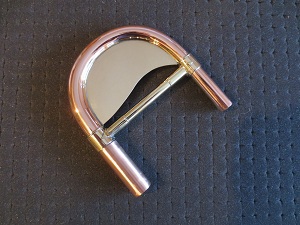Here's an example of what I'm talking about:


even better, make 1 tuning slide and play the horn with it and then solder on the plate and then play with it in that state. so yo get the closest examination to "identical tuning slides"UATrombone wrote: ↑Sun Jan 19, 2025 4:35 am Best way to check the effects is to make 2 identical (OK, almost identical) tuning slides and add such plate to one of them for direct comparison.
It was my first thought but in this case you can't do continuous direct comparison (A-B-A-B....) because of time needed to solder/unsolder that plate...NotSkilledHere wrote: ↑Sun Jan 19, 2025 5:33 am even better, make 1 tuning slide and play the horn with it and then solder on the plate and then play with it in that state. so yo get the closest examination to "identical tuning slides"
For amusement, as I build and modify a few horns, when putting them back together I assemble the tuning slide without the cross brace. I do this knowing I can test it and feel it out and then add the cross brace back if I need or want it. I have not added back the cross brace to my 42, my 45, or my 50 based horns. It does somewhat negatively mess with the balance, so I will do something about that, but I’m going on 20 years of taking these things out and leaving them out.Slidennis wrote: ↑Mon Jan 20, 2025 5:52 am Yet more interesting to me : brace or no brace on the tuning slide...
Yamaha was the first trombones I didn't see a brace on, then on my Conn 71H...
All the Rath's...
Lately, I had a tuning slide of a Conn 88H that was a bit tricky to put on the bell after I took it out, and I found this Conn 88H to be a bit stiff.
I wanted to keep the brace to put a counterweight on it if needed, so I just made a cut in the brace with a Dremel right in the middle of it... ...BANG, the small cut opened at once with a noise, and sure, tension was realeased !!! A big improvement in sound, livelier bell, and easier to pull back and forth... FWIW...
Soldering that on could change the alignment of the tuning slide legs and either add or release tension, which definitely can affect how the horn blows. So that's not even a perfect way to do the experiment.NotSkilledHere wrote: ↑Sun Jan 19, 2025 5:33 ameven better, make 1 tuning slide and play the horn with it and then solder on the plate and then play with it in that state. so yo get the closest examination to "identical tuning slides"UATrombone wrote: ↑Sun Jan 19, 2025 4:35 am Best way to check the effects is to make 2 identical (OK, almost identical) tuning slides and add such plate to one of them for direct comparison.
Some times it also can lead to too much slotting and stifness, above all if your bell is not annealed, like my 88HTO, but I like to put a counterweight on the F att tuning slide, at the very end of the lower tubing, for balance sake, certainly the times I put scores on a lyra attached on my bell...timbone wrote: ↑Wed Feb 05, 2025 6:51 pm I am a strong advocate of such mass at the extremities of the trombone. Think of it like your hands and feet being the furthest from the heart- the tuning slide and end crook are the same way, although instead of blood loss, we have vibration loss, which leads to less slotting and core.